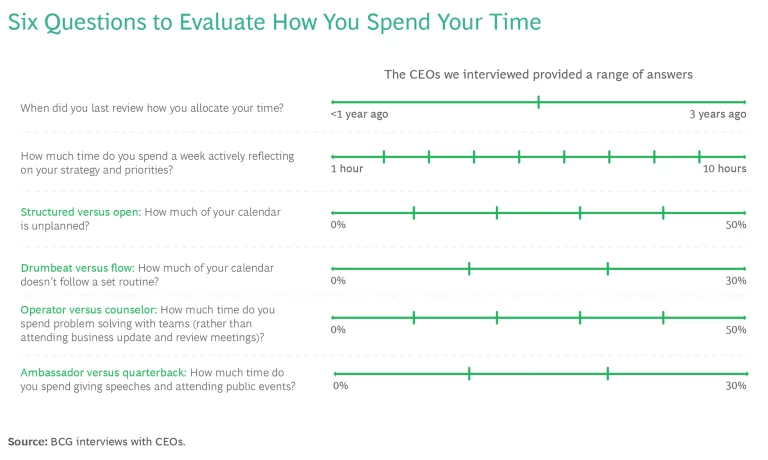Time is the CEO’s most valuable resource. How CEOs spend their time has an outsized influence on performance, engagement, and company culture. Successful CEOs have different— often vastly different—approaches to their calendar. Some are fully booked months in advance; others leave half their days open for deep reflection, spontaneous meetings, and coaching. Some delegate the management of their calendar to an executive assistant or a chief of staff; others do it themselves. (See “The CEO’s Inner Circle.”)
The CEO’s Inner Circle
What all have in common is a love for their work and a belief that the way they spend their time matters. As the CEO of a $30 billion company told us, “I decided early in my career that anyone who has a system and philosophy about time usage is ahead of those who don’t.”
We have worked closely with CEOs in a variety of industries in the US, Europe, and Asia and have seen numerous time management models at work. Our observations suggest four fundamental differences in how they spend their time, how they approach their work, and how they believe they can add value. We characterize these differences as:
- Structured versus open
- Drumbeat versus flow
- Operator versus counselor
- Ambassador versus quarterback
Each of these choices is made according to the industry, the current situation, and the personality of the individual CEO. Some industries require more of a hands-on presence, while those under heavy regulation may demand a more public profile. Natural extroverts will manage their calendars differently from introverts.
The bottom line is that CEOs should put deliberate thought into their calendar. This may call for changes that are relatively easy to make, but some CEOs may have to move outside their comfort zone. Postpandemic, they may also need to decide how their use of virtual communication ought to shift. (See “The Pandemic’s Lasting Effect.”)
The Pandemic’s Lasting Effect
Structured Versus Open CEO
The calendars of structured CEOs are full of meetings, events, and other commitments. “I never kept a slot open,” the former chief of staff for the CEO of a global manufacturing company said. “I was building the agenda. It was always at the right time with the right people on the right subject in the right geography. So every day was full.”
In contrast, open CEOs leave parts of the day free so they’re available to their teams and are free to address unplanned developments. One leader we spoke with, who has served in the role for more than ten years, does not have any scheduled meetings with his nine direct reports. “I don’t believe in formalizing and putting structure around those things because then it becomes forced, and you end up wasting time,” he said. “I try to be in a situation where if a member of the leadership team wants to talk to me, I can do so within an hour or two. The odds of them having to wait a day are almost zero.”
Another former CEO, who ran a global business worth more than $100 billion, would schedule 30-minute meetings but leave as much as an hour and a half free afterwards. The 30-minute allotment encouraged participants to be concise, while the 90-minute buffer allowed for productive meetings to go on longer as needed.
Drumbeat Versus Flow CEO
CEOs also have different views of how rigorously to manage and track their time. Some know their calendar, with its rhythm of meetings, events, and travel, a year in advance. Their calendar may even be color-coded, with each color corresponding to a quarterly or other objective. As the CEO of a large European manufacturer told us, “On an annual basis, even longer, we have a management cadence that forces particular outcomes.” That cadence “translates into monthly meetings, quarterly business reviews, five board meetings a year,” and so on.
Some CEOs know their calendar a year in advance. For others, this sort of discipline is not always possible or desirable.
For others, this sort of discipline is not always possible or desirable. They prefer to adapt, spending time where they think they can be most useful. “This is a servant-leadership
job
, so you have to be flexible,” said the former CEO of a global professional-services firm. “I’m much more of a flow than a rigor person.” His calendar included a foundation of regular events but otherwise evolved according to emerging priorities.
Operator Versus Counselor CEO
CEOs are involved to different degrees in the day-to-day running of the business. Operators want to be deeply engaged; their calendars prioritize status update and business review meetings. Counselors are more focused on thinking strategically about the business and on coaching and mentoring the people they have put in charge of the various lines of business and functions.
One CEO we spoke with meets individually every month with the heads of each business and conducts a monthly operational review of the business groups. Another, who runs the large subsidiary of a global company, takes a more hands-off approach. This CEO focuses on just two strategic priorities, dealmaking and service revenue growth, and spends most of the rest of the time with clients and direct reports. A third CEO prefers to spend most of his time coaching his direct reports rather than managing the details of the business. Another instituted “mentoring Monday,” requiring executives to spend at least half the day coaching their direct reports.
The approach of a global manufacturing CEO lies somewhere in the middle. As supply chain issues recede, he wants to step back from day-to-day operations. “I shouldn’t be running the business and should be spending more time on people, strategy, and customers,” he said. “The operational activities should happen pretty naturally.”
One potential risk of the operator approach is that CEOs who are constantly looking at what’s happening in the business may not have time for reflection. Those who give themselves the opportunity to stand back and think about the business as a whole say it is time well spent, leading to better insights into innovation, strategy, and execution. One CEO has large “blue blocks” of time set aside on the calendar to think strategically and be available to senior executives. Another imagines future scenarios for the business during “magic wand moments.”
CEOs who give themselves the opportunity to stand back and think about the business say it is time well spent.
The choice between operator and counselor may partly depend on the needs of different types of businesses. Although all industries are facing disruptive forces that demand long-term thinking, manufacturers and other asset-heavy industries may be well served by CEOs with an operational orientation. In contrast, companies whose current sources of advantage and growth are under attack will likely benefit from a counselor CEO.
Ambassador Versus Quarterback CEO
Some CEOs place a high value on their public roles, whether connecting with employees in town halls, Zoom events, and visits to offices and plants or speaking at industry gatherings and meeting with officials from government and NGOs. Others prioritize spending their time working with direct reports and teams in small group settings.
The pressure to show up in public is rising: a CEO of a high-profile global company reported giving 200 speeches in a year. Employees and outside stakeholders often expect CEOs to take a stand on social issues and perform other public functions.
But many find this ambassador role exhausting. One CEO told us that attending big public events was the most “energy-draining part” of his job. Others question the value of such events and prefer to be quarterbacks, working directly with their teams. “Where I can have the biggest impact today is building the right senior management team and interacting with them to shape their philosophy and strategy,” one CEO said. “One of the least effective things in the business world is big group dinners.”
Time Well Spent
The typical day of a CEO varies from individual to individual. Many leaders give serious thought to their calendar and to how their time and presence will make the most difference. But like everyone, CEOs are hostage to their preferences, personalities, and histories—and to inertia. They may believe that their particular industry or their company’s current situation imposes specific demands on their time. And yet we have seen CEOs in the same industry, facing the same competitive dynamics, take vastly different approaches to time management.
There is no single way to manage time that will ensure success. But as an organization grows, and as teams change and challenges evolve, CEOs may do well to step back and consider how to better tailor their calendar.
An unexamined calendar is a missed opportunity to become a more effective leader. The exhibit below shows six questions we asked CEOs about how they spend their time and the range of answers we received. The degree of variation may come as a surprise. Use your own answers, along with your understanding of your organization’s needs, to identify potential changes in the way you manage your time. For example: Are many meetings starting late because of tight schedules? Are regularly scheduled meetings not leading to the solution of problems? Do different leaders in your organization require different amounts of time for mentoring from you, the CEO? Do you feel you’re not getting the expected value from public appearances and large group meetings? Are some of your personal preferences counterproductive? If so, it may make sense to fine-tune or rethink your calendar—and boost your return on your time.

The authors thank Chai Lu Clark, Melanie Gaynes, and Cody Storm for their contributions to this article.








